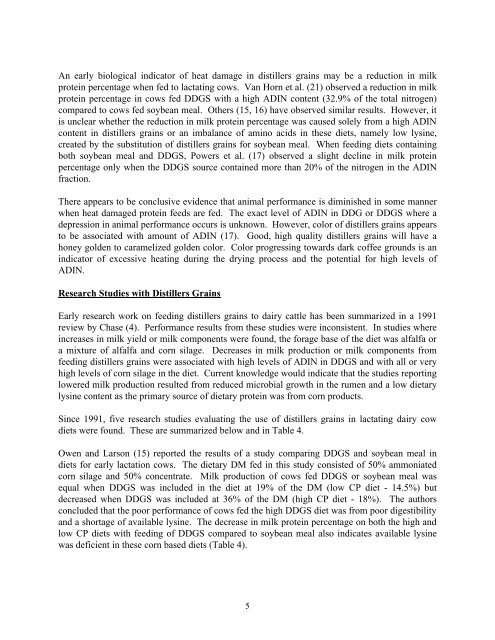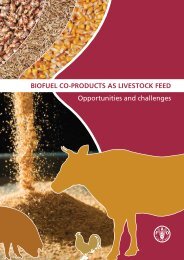Distillers Grains Feeding Recommendations. - Distillers Grains By ...
Distillers Grains Feeding Recommendations. - Distillers Grains By ...
Distillers Grains Feeding Recommendations. - Distillers Grains By ...
You also want an ePaper? Increase the reach of your titles
YUMPU automatically turns print PDFs into web optimized ePapers that Google loves.
An early biological indicator of heat damage in distillers grains may be a reduction in milkprotein percentage when fed to lactating cows. Van Horn et al. (21) observed a reduction in milkprotein percentage in cows fed DDGS with a high ADIN content (32.9% of the total nitrogen)compared to cows fed soybean meal. Others (15, 16) have observed similar results. However, itis unclear whether the reduction in milk protein percentage was caused solely from a high ADINcontent in distillers grains or an imbalance of amino acids in these diets, namely low lysine,created by the substitution of distillers grains for soybean meal. When feeding diets containingboth soybean meal and DDGS, Powers et al. (17) observed a slight decline in milk proteinpercentage only when the DDGS source contained more than 20% of the nitrogen in the ADINfraction.There appears to be conclusive evidence that animal performance is diminished in some mannerwhen heat damaged protein feeds are fed. The exact level of ADIN in DDG or DDGS where adepression in animal performance occurs is unknown. However, color of distillers grains appearsto be associated with amount of ADIN (17). Good, high quality distillers grains will have ahoney golden to caramelized golden color. Color progressing towards dark coffee grounds is anindicator of excessive heating during the drying process and the potential for high levels ofADIN.Research Studies with <strong>Distillers</strong> <strong>Grains</strong>Early research work on feeding distillers grains to dairy cattle has been summarized in a 1991review by Chase (4). Performance results from these studies were inconsistent. In studies whereincreases in milk yield or milk components were found, the forage base of the diet was alfalfa ora mixture of alfalfa and corn silage. Decreases in milk production or milk components fromfeeding distillers grains were associated with high levels of ADIN in DDGS and with all or veryhigh levels of corn silage in the diet. Current knowledge would indicate that the studies reportinglowered milk production resulted from reduced microbial growth in the rumen and a low dietarylysine content as the primary source of dietary protein was from corn products.Since 1991, five research studies evaluating the use of distillers grains in lactating dairy cowdiets were found. These are summarized below and in Table 4.Owen and Larson (15) reported the results of a study comparing DDGS and soybean meal indiets for early lactation cows. The dietary DM fed in this study consisted of 50% ammoniatedcorn silage and 50% concentrate. Milk production of cows fed DDGS or soybean meal wasequal when DDGS was included in the diet at 19% of the DM (low CP diet - 14.5%) butdecreased when DDGS was included at 36% of the DM (high CP diet - 18%). The authorsconcluded that the poor performance of cows fed the high DDGS diet was from poor digestibilityand a shortage of available lysine. The decrease in milk protein percentage on both the high andlow CP diets with feeding of DDGS compared to soybean meal also indicates available lysinewas deficient in these corn based diets (Table 4).5
















